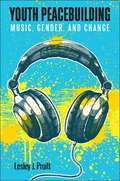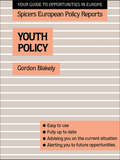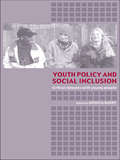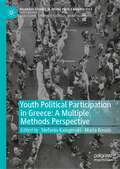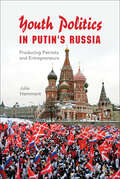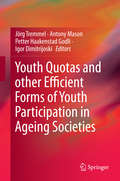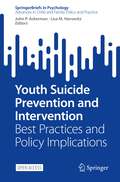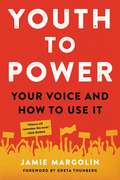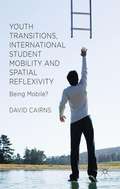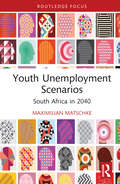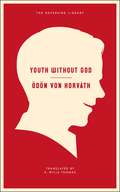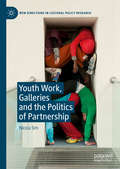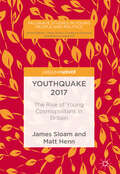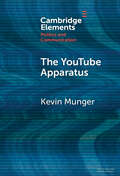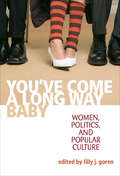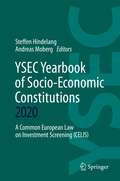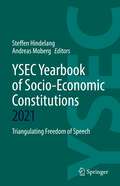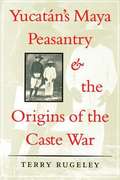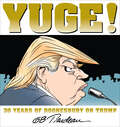- Table View
- List View
Youth Peacebuilding: Music, Gender, and Change (SUNY series, Praxis: Theory in Action)
by Lesley J. PruittThis book highlights the important role youth can play in processes of peacebuilding by examining music as a tool for engaging youth in such activities. As Lesley J. Pruitt discusses throughout the book, music—as expression, as creation, as inspiration—can provide many unique insights into transforming conflicts, altering our understandings, and achieving change. She offers detailed empirical work on two youth peacebuilding programs in Australia and Northern Ireland, countries that appear overtly peaceful, but where youth still face structural violence and related direct violence at the community level. She also pays careful attention to the ways in which gender norms might influence young people's participation in music-based peacebuilding activities. Ultimately, the book defines a new research area linking youth cultures and music with peacebuilding practice and policy.
Youth Planning Charrettes: A Manual for Planners, Teachers, and Youth Advocates
by Bruce RaceInvest in the future! Involve young people in planning. Learn how to design charrettes, starting with workshops and ending with lessons learned. This book explores various approaches to involving youth in schools, museums, and citizen groups. It's a complete guide to successful community charrettes for younger participants (K-8). First published in 1998. Routledge is an imprint of Taylor & Francis, an informa company.
Youth Policy (Spicers European Policy Reports)
by Gordon BlakelyEuropean co-operation has a special role in relation to youth. Both the Council of Europe and the European Community have developed specific initiatives to promote the interests of youth, and to place them in a European-wide context. These initiatives cover economic, social, educational and cultural matters. New opportunities have been created for youth exchanges and an increasingly important application of the EC Social Fund is concerned with youth issues. This volume has a wider focus than the others in this series in that it covers the initiatives of both the European Community and some of the work done by the Council of Europe. It explains how their youth policies have developed, the differences between them, it guides the reader as to its current programmes, and it also discusses proposals affecting the immediate future. This volume will be of special interest to the diverse audience concerned with youth policy: public administrators, educationalists, social and cultural bodies, youth representatives and young individuals.
Youth Policy and Social Inclusion: Critical Debates with Young People
by Monica BarryTaking a holistic and multidisciplinary approach this book identifies and analyzes the factors which promote or discourage social inclusion of young people in today’s society. It critically examines the discriminatory attitudes towards young people, and focuses on the 'problem' of adults rather than the 'problem' of young people themselves. The authors ask searching questions about society's capacity and willingness to be more socially inclusive of young people in terms of policy and practice, and explore the extent to which young people have access to status, rights and responsibilities as young adults. Challenging existing theory the book covers issues including: citizenship, education, rights, youth transactions, drug use, homelessness, teenage pregnancy and unemployment. Incorporating the views and experiences of young people themselves, the book highlights the strengths and weaknesses of the academic contribution and suggests ways forward for a more inclusive society.
Youth Political Participation in Greece: A Multiple Methods Perspective (Palgrave Studies in Young People and Politics)
by Stefania Kalogeraki Maria KousisThe overarching aim of this edited volume is to investigate different modes, patterns and determinants of youth political participation in Greece, since the economic crisis, by incorporating a variety of quantitative and qualitative methods. The chapters examine different forms of youth political participation, from institutionalized (such as voting, or membership in political parties) to non-institutionalized (such as signing petitions, protesting through demonstrations or occupations, and political consumerism). Moreover, the chapters shed light on diverse aspects of youth political participation, such as the interlinkages between occupational precarity and political behaviour, the spatial portrait of youth political engagement in rural, suburban and urban Greek contexts, the engendered aspects of political involvement, the pivotal role of protest events in youth political socialization and in mobilization in contentious political actions, the different impacts of priming inequality on youth’s political beliefs, depending on different modes of thinking, as well as the key features of youth-related and youth-led (non-state) organisations operating in Greece. The aforementioned aspects are examined at the micro, meso or/and macro level through distinct methodological approaches including panel survey, experimental survey, biographical interviews, in-depth interviews and action organization analysis, carried out in the context of the EURYKA (European Commission) project.
Youth Politics in Putin's Russia: Producing Patriots And Entrepreneurs (New Anthropologies of Europe)
by Julie HemmentJulie Hemment provides a fresh perspective on the controversial nationalist youth projects that have proliferated in Russia in the Putin era, examining them from the point of view of their participants and offering provocative insights into their origins and significance. The pro-Kremlin organization Nashi ("Ours") and other state-run initiatives to mobilize Russian youth have been widely reviled in the West, seen as Soviet throwbacks and evidence of Russia's authoritarian turn. By contrast, Hemment's detailed ethnographic analysis finds an astute global awareness and a paradoxical kinship with the international democracy-promoting interventions of the 1990s. Drawing on Soviet political forms but responding to 21st-century disenchantments with the neoliberal state, these projects seek to produce not only patriots, but also volunteers, entrepreneurs, and activists.
Youth Quotas and other Efficient Forms of Youth Participation in Ageing Societies
by Jörg Tremmel Antony Mason Petter Haakenstad Godli Igor DimitrijoskiThis book examines ways to ensure that the rights, interests and concerns of young people are properly represented in Western democracies. One new proposal is the introduction of youth quotas in political institutions in order to counter the possible marginalization of young people caused by demographic ageing and, thereby, an overrepresentation of the interests of the elderly. The book explores key questions regarding the implementation of youth quotas from different perspectives, including philosophy, political science, sociology and demography. It examines whether youth quotas and other measures that give the young more voice and influence in political institutions are a good means for promoting the cause of intergenerational justice. In particular, it investigates how and if youth quotas can be used to ensure that the environmental interests of young and future generations are being taken into account. In addition, the book introduces an innovative model that would give a right to vote to minors without voting age boundaries. The book also discusses suffrage reforms through lowering the voting age in Western countries, as well as introducing methods especially aimed at raising the skills of children necessary for societal citizenship and empowerment of young citizens. The volume will help raise awareness and knowledge about the intergenerational implications of demographic changes in Western democracies, where ageing societies are increasingly turning into gerontocracies. It offers readers deep insight into how youth quotas in particular (and others forms of youth participation in general) might be efficient methods to ensure that younger generations are included in the political decision making process and other activities in society.
Youth Suicide Prevention and Intervention: Best Practices and Policy Implications (SpringerBriefs in Psychology)
by John P. Ackerman Lisa M. HorowitzThis open access book focuses on the public health crisis of youth suicide and provides a review of current research and prevention practices. It addresses important topics, including suicide epidemiology, suicide risk detection in school and medical settings, critical cultural considerations, and approaches to lethal means safety. This book offers cutting-edge research on emerging discoveries in the neurobiology of suicide, psychopharmacology, and machine learning. It focuses on upstream suicide prevention research methods and details how cost-effective approaches can mitigate youth suicide risk when implemented at a universal level. Chapters discuss critical areas for future research, including how to evaluate the effectiveness of suicide prevention and intervention efforts, increase access to mental health care, and overcome systemic barriers that undermine generalizability of prevention strategies. Finally, this book highlights what is currently working well in youth suicide prevention and, just as important, which areas require more attention and support. Key topics include: The neurobiology of suicide in at-risk children and adolescents.The role of machine learning in youth suicide prevention.Suicide prevention, intervention, and postvention in schools.Suicide risk screening and assessment in medical settings.Culturally informed risk assessment and suicide prevention efforts with minority youth.School mental health partnerships and telehealth models of care in rural communities.Suicide and self-harm prevention and interventions for LGBTQ+ youth.Risk factors associated with suicidal behavior in Black youth.Preventing suicide in youth with autism spectrum disorder (ASD) and intellectual disability (ID). Youth Suicide Prevention and Intervention is a must-have resource for policy makers and related professionals, graduate students, and researchers in child and school psychology, family studies, public health, social work, law/criminal justice, sociology, and all related disciplines.
Youth to Power: Your Voice and How to Use It
by Jamie Margolin"Jamie Margolin is among the powerful and inspiring youth activists leading a movement to demand urgent action on the climate crisis. With determined purpose and moral clarity, Jamie is pushing political leaders to develop ambitious plans to confront this existential threat to humanity. Youth To Power is an essential how-to for anyone of any age who feels called to act to protect our planet for future generations." --- Former Vice President Al GoreClimate change activist and Zero Hour cofounder Jamie Margolin offers the essential guide to changemaking for young people.The 1963 Children's March. The 2016 Dakota Access Pipeline protests. March for Our Lives, and School Strike for Climate. What do all these social justice movements have in common?They were led by passionate, informed, engaged young people.Jamie Margolin has been organizing and protesting since she was fourteen years old. Now the co-leader of a global climate action movement, she knows better than most how powerful a young person can be. You don't have to be able to vote or hold positions of power to change the world.In Youth to Power, Jamie presents the essential guide to changemaking, with advice on writing and pitching op-eds, organizing successful events and peaceful protests, time management as a student activist, utilizing social and traditional media to spread a message, and sustaining long-term action. She features interviews with prominent young activists including Tokata Iron Eyes of the #NoDAPL movement and Nupol Kiazolu of the #BlackLivesMatter movement, who give guidance on handling backlash, keeping your mental health a priority, and how to avoid getting taken advantage of.Jamie walks readers through every step of what effective, healthy, intersectional activism looks like. Young people have a lot to say, and Youth to Power will give you the tools to raise your voice.
Youth Transitions, International Student Mobility and Spatial Reflexivity
by David CairnsDrawing on comparative country case studies, this book explores student mobility in Europe, incorporating original theoretical perspectives to explain how mobility happens and new empirical evidence to illustrate how students become mobile within their present educational and future working lives.
Youth Unemployment Scenarios: South Africa in 2040 (Routledge Contemporary South Africa)
by Maximilian MatschkeThis book examines the factors driving youth unemployment in South Africa, exploring potential future outcomes of its mass unemployment, and offering a variety of strategies to avoid an impending crisis in the country. Utilizing scenario analysis rooted in complex systems theory while building on statistical and fi eld research, the author illustrates four possible future states of youth employment in South Africa in the year 2040. This includes the South African version of the Arab Spring, where young people riot or agitate for extreme political and social change because of a belief that access to education and jobs is only possible through social status or corruption (Spring), fair access to a high number of jobs supported by Chinese interventions (Summer), a technology- driven decline in the number of jobs where merit- based access for youth is granted (Fall), and the collapse of the economy, with the economy collapsing and youth becoming increasingly desperate (Winter). The author then presents five strategies to fight youth unemployment, including training of youth to start businesses, stimulating small- and medium- sized enterprises, and sending unemployed youth abroad for skills development and to where their labour is needed. This book will be of interest to scholars of South African politics and economics, labour economics and youth studies, and readers with an interest in tackling youth unemployment independent of the country.
Youth Without God (Neversink)
by Odon Von Horvath R. Wills Thomas Liesl SchillingerWritten in exile while in flight from the Nazis, this dark, bizarre evocation of everyday life under fascism is available for the first time in thirty years. This last book by Ödön von Horváth, one of the 20th-century's great but forgotten writers, is a dark fable about guilt, fate, and the individual conscience.An unnamed narrator in an unnamed country is a schoolteacher with "a safe job with a pension at the end of it." But, when he reprimands a student for a racist comment, he is accused of "sabotage of the Fatherland," and his students revolt. A murder follows, and the teacher must face his role in it, even if it costs him everything. Horváth's book both points to its immediate context--the brutalizing conformity of a totalitarian state, the emptiness of faith in the time of the National Socialists--and beyond, to the struggles of individuals everywhere against societies that offer material security in exchange for the abandonment of one's convictions. Reminiscent of Camus' The Stranger in its themes and its style, Youth Without God portrays a world of individual ruthlessness and collective numbness to the appeals of faith or morality. And yet, a commitment to the truth lifts the teacher and a small band of like-minded students out of this deepening abyss. It's a reminder that such commitment did exist in those troubled times--indeed, they're what led the author to flee Germany, first for Austria, and then France, where he met his death in a tragic accident, just two years after the publication of Youth Without God. Long out of print, this new edition resurrects a bracing and still-disturbing vision. "Horváth was telling the truth. Furiously." --Shalom AuslanderFrom the Trade Paperback edition.
Youth Work, Galleries and the Politics of Partnership (New Directions in Cultural Policy Research)
by Nicola SimThis book sheds critical light on the routinely debated issue of how to create sustainable, equitable and meaningful partnerships between visual art organisations and youth organisations. Using a Bourdieusian framework, this book analyses the different social and professional worlds of youth work and gallery education and explores why tensions often arise between partners and young people in these fields. Written at a time of significant crisis for the UK youth sector and in the context of an entrenched neoliberal policy climate, this publication seeks to highlight hopeful, experimental practice and possibilities for creative resistance. With public organisations and services under ever-greater governmental pressure to pursue collaborations within and across sectors, this is a timely moment to examine the challenges, ethics and advantages of working together, and to bring theoretical discussion to dominant yet vague understandings of partnership.
Youthquake 2017: The Rise of Young Cosmopolitans in Britain (Palgrave Studies in Young People and Politics)
by James Sloam Matt HennThis book is open access under a CC BY 4.0 license.This book investigates the reasons behind the 2017 youthquake – which saw the highest rate of youth turnout in a quarter of a century, and an unprecedented gap in youth support for Labour over the Conservative Party – from both a comparative and a theoretical perspective. It compares youth turnout and party allegiance over time and traces changes in youth political participation in the UK since the onset of the 2008 global financial crisis – from austerity, to the 2016 EU referendum, to the rise of Corbyn – up until the June 2017 General Election. The book identifies the rise of cosmopolitan values and left-leaning attitudes amongst Young Millennials, particularly students and young women. The situation in the UK is also contrasted with developments in youth participation in other established democracies, including the youthquakes inspired by Obama in the US (2008) and Trudeau in Canada (2015).
The YouTube Apparatus (Elements in Politics and Communication)
by null Kevin MungerThe academic agenda for studying social media and politics has been somewhat haphazard. Thanks to rapid technological change, a cascade of policy-relevant crises, and sheer scale, we do not have a coherent framework for deciding what questions to ask. This Element articulates such a framework by taking existing literature from media economics and sociology and applying it reflexively, to both the academic agenda and to the specific case of politics on YouTube: the Supply and Demand Framework. The key mechanism, traced over the past century, is the technology of audience measurement. The YouTube audience comes pre-rationalized in the form of Likes, Views and Comments, and is thus unavoidable for all actors involved. The phenomenon of 'radicalization' is best understood as a consequence of accelerated feedback between audiences and creators, radicalizing each other. I use fifteen years of supply and demand data from YouTube to demonstrate how different types of producers respond more or less to this feedback, which in turn structures the ideological distribution of content consumed on the platform.
You've Changed: Fake Accents, Feminism, and Other Comedies from Myanmar
by Pyae Moe WarIn this electric debut essay collection, a Myanmar millennial playfully challenges us to examine the knots and complications of immigration status, eating habits, Western feminism in an Asian home, and more, guiding us toward an expansive idea of what it means to be a Myanmar woman todayWhat does it mean to be a Myanmar person—a baker, swimmer, writer and woman—on your own terms rather than those of the colonizer? These irreverent yet vulnerable essays ask that question by tracing the journey of a woman who spent her young adulthood in the US and UK before returning to her hometown of Yangon, where she still lives. In You&’ve Changed, Pyae takes on romantic relationships whose futures are determined by different passports, switching accents in American taxis, the patriarchal Myanmar concept of hpone which governs how laundry is done, swimming as refuge from mental illness, pleasure and shame around eating rice, and baking in a kitchen far from white America&’s imagination. Throughout, she wrestles with the question of who she is—a Myanmar woman in the West, a Western-educated person in Yangon, a writer who refuses to be labeled a &“race writer.&” With intimate and funny prose, Pyae shows how the truth of identity may be found not in stability, but in its gloriously unsettled nature.
You've Come A Long Way, Baby: Women, Politics, and Popular Culture
by Lilly J. GorenNo matter what brand of feminism one may subscribe to, one thing is indisputable: the role of women in society during the past several decades has changed dramatically, and continues to change in a variety of ways. In You've Come a Long Way, Baby, Lilly J. Goren and an impressive group of contributors explore the remarkable advancement achieved by American women in a historically patriarchal social and political landscape, while examining where women stand today and contemplating the future challenges they face worldwide. As comprehensive as it is accessible, You've Come a Long Way, Baby appeals to anyone interested in confronting the struggles and celebrating the achievements of women in modern society.
You've Got Dissent! Chinese Dissident Use of the Internet and Beijing's Counter-Strategies
by Michael S. Chase James C. MulvenonAn analysis of the political use of the Internet by Chinese dissidents, both in the PRC and abroad, and the counterstrategies that Beijing has employed to prevent or minimize its impact. Although PRC officials have responded to the increased use of the Internet with predominantly traditional measures, they have been relatively successful. No credible challenges to the regime exist at present, despite the introduction of a massive modern telecommunications infrastructure. However, time may be on the side of the regime's opponents.
YSEC Yearbook of Socio-Economic Constitutions 2020: A Common European Law on Investment Screening (CELIS) (YSEC Yearbook of Socio-Economic Constitutions #2020)
by Steffen Hindelang Andreas MobergThis book presents the very first, interdisciplinarily grounded, comprehensive appraisal of a future “Common European Law on Investment Screening”. Thereby, it provides a foundation for a European administrative law framework for investment screening by setting out viable solutions and evaluating their pros and cons. Daimler, the harbour terminal in Zeebrugge, or Saxo Bank are only three recent examples of controversially discussed company takeovers in Europe. The “elephant in the room” is China and its “Belt and Road Initiative”. The political will in Europe is growing to more actively control investments flowing into the EU. The current regulatory initiatives raise several fundamental, constitutional and regulatory issues. Surprisingly, they have not been addressed in any depth so far. The book takes stock of the current rather fragmented regulatory approaches and combines contributions from leading international academics, practitioners, and policy makers in their respective fields. Due to the volume’s comprehensive approach, it is expected to influence the broader debate on the EU’s upcoming regulation of this matter. The book is addressed to participants from academia as well as to representatives from government, business, and civil society.
YSEC Yearbook of Socio-Economic Constitutions 2021: Triangulating Freedom of Speech (YSEC Yearbook of Socio-Economic Constitutions #2021)
by Steffen Hindelang Andreas MobergThis volume addresses contemporary challenges, enabled by modern technology, that concern upholding freedom of speech where it conflicts with social rights, such as respect for private and family life, and with economic rights, such as the freedom to conduct business or the right to free movement. In today’s networked world, technological shifts happen faster than most people even realize. Some of these shifts have made us all potentially powerful: media powerful. We used to sit in silence in front of newspapers and TV screens, and the world was explained to us by just a few sources. Today, thanks to the Internet, social media, and Web 2.0, we can not only share our own thoughts with everyone in a more self-determined way, but we can also take part in public debate and even co-shape it ourselves. Of course, the Internet is not a counter-design to the communication (power) structures of the past. Gains in communicative self-determination are threatened due to algorithmisation, platformisation, and value extraction from self-created private markets. At the same time, the empowerment of the individual challenges the old “grand speakers” who are suddenly detecting “fake news”, echo chambers, and filter bubbles everywhere on the Internet. Internet-based communication allegedly hinders us from the “one truth”; as if newspaper hoaxes, propaganda, and narrow-mindedness were an invention of the Internet. The current heated debate over “fake news”, copyright, and “upload filters” shows that we are unsure of how to deal with the newer and more complex phenomena of Internet-based speech. This is due in no small part to the fact that an important benchmark – our constitutional compass – is still firmly rooted in the past. Constitutions change far more slowly than technologies. Societal changes can drive constitutional changes; but what about normative content control? Today, there are already demands for “old-school clarity”: truth filters on social media platforms, horrendous sums of liability for platforms that encourage (overly)thorough cleaning up. However, it is equally true that private individuals “regulate”: they decide what is found on the Internet and who may post on a given platform. Accounting for all interests at play and striking a “fair” balance that avoids both a public and private over- and under-regulation is a complex matter. The authors of this volume not only provide reflections in their highly topical contributions, but also share their understanding of what constitutes a fair balance within the larger frame of freedom of speech in a digital age.
Yuan Mei: Eighteenth Century Chinese Poet (China: History, Philosophy, Economics #XXXVIII)
by Arthur Waley The Arthur EstateFirst published in 1956. Arthur Waley here presents an engrossing account of the works and life of Yuan Mei (1716-1797), the best-known poet of his time. Gaiety is the keynote of his works and the poet was a friend of the Manchu official with whom Commodore Anson had dramatic dealings at Canton in 1743. Yuan Mei gives an account (not previously translated) of Anson's interview with the Manchu authorities. The book contains many translations of Yuan Mei's verse and prose.
Yucatán's Maya Peasantry and the Origins of the Caste War
by Terry RugeleyConflicts between native Maya peoples and European-derived governments have punctuated Mexican history from the Conquest in the sixteenth century to the current Zapatista uprising in Chiapas. In this deeply researched study, Terry Rugeley delves into the 1800-1847 origins of the Caste War, the largest and most successful of these peasant rebellions.<P><P>Rugeley refutes earlier studies that seek to explain the Caste War in terms of a single issue. Instead, he explores the interactions of several major social forces, including the church, the hacienda, and peasant villagers. He uncovers a complex web of issues that led to the outbreak of war, including the loss of communal lands, substandard living conditions, the counterpoise of Catholicism versus traditional Maya beliefs, and an increasingly heavy tax burden. <P> Drawn from a wealth of primary documents, this book represents the first real attempt to reconstruct the history of the pre-Caste War period. In addition to its obvious importance for Mexican history, it will be illuminating background reading for everyone seeking to understand the ongoing conflict in Chiapas.
Yuge!: 30 Years of Doonesbury on Trump (Doonesbury Ser. #37)
by G. B. TrudeauA NEW YORK TIMES BEST SELLER!He tried to warn us. Ever since the release of the first Trump-for-President trial balloon in 1987, Doonesbury&’s Garry Trudeau has tirelessly tracked and highlighted the unsavory career of the most unqualified candidate to ever aspire to the White House. It&’s all there—the hilarious narcissism, the schoolyard bullying, the loathsome misogyny, the breathtaking ignorance; and a good portion of the Doonesbury cast has been tangled up in it. Join Duke, Honey, Earl, J.J., Mike, Mark, Roland, Boopsie, B.D., Sal, Alice, Elmont, Sid, Zonker, Sam, Bernie, Rev. Sloan, and even the Red Rascal as they cross storylines with the big, orange airhorn who&’s giving the GOP such fits.Garry Trudeau is the &“sleazeball&” &“third-rate talent&” who draws the &“overrated&” comic strip Doonesbury, which &“very few people read.&” He lives in New York City with his wife Jane Pauley, who &“has far more talent than he has."
Yugoslav-American Economic Relations Since World War II
by Russell O. Prickett John R. Lampe Ljubisa S. AdamovicYugoslav-American Economic Relations Since World War II provides a comprehensive study of the economic relations between the United States and Yugoslavia over the past four decades. The authors recount how Yugoslavia and the United States, despite great differences in size, wealth, and ideology, overcame early misunderstandings and confrontations to create a generally positive economic relationship based on mutual respect. The Yugoslav experience demonstrated, the authors maintain, that existence outside the bloc was possible, profitable, and nonthreatening to the Soviet Union.The authors describe American official and private support for Yugoslavia's decades-long efforts at economic reform that included the first foreign investment legislation in 1967 and the first introduction of convertible currency in 1990 for any communist country. Also examined are the origins of Yugoslavia's international debt crisis of the early 1980s and the American role in the highly complex multibillion-dollar international effort that helped Yugoslavia surmount that crisis.In the past, U.S. support for the Yugoslav economy was proffered in part, the authors claim, to counter perceived threats from the Soviet Union and its allies. This may have enabled Yugoslavia to avoid some of the hard but necessary economic policy choices; hence, future U.S. support, the book concludes, will likely be tied more closely to the economic and political soundness of Yugoslavia's own actions.
Yugoslavia and After: A Study in Fragmentation, Despair and Rebirth
by David A. Dyker Ivan VejvodaThis new book presents contributions by leading authorities on the origins of the Balkan crisis, the reasons for the decay and dissolution of the old Yugoslavia, the nature of the new regimes, the prospects for solution of the remaining conflicts and for the building of viable successor states.
